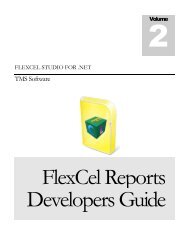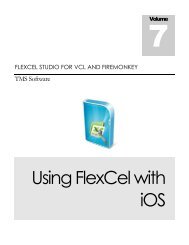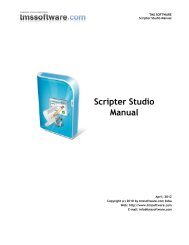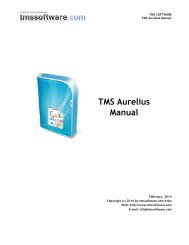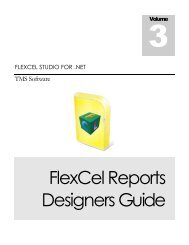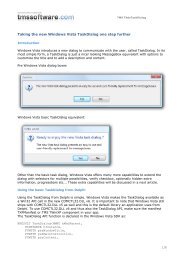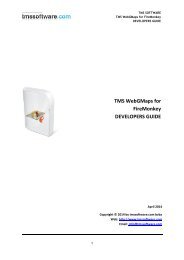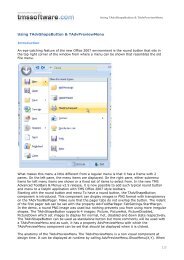Exporting Excel files to PDF - TMS Software
Exporting Excel files to PDF - TMS Software
Exporting Excel files to PDF - TMS Software
You also want an ePaper? Increase the reach of your titles
YUMPU automatically turns print PDFs into web optimized ePapers that Google loves.
<strong>TMS</strong> SOFTWARE<br />
FLEXCEL STUDIO FOR .NET<br />
Using FlexCelPdfExport on MONO (linux)<br />
Mono is an incredible platform <strong>to</strong> deploy your .NET applications, and as FlexCel.NET is 100% managed<br />
code, most of the time running a FlexCel.NET application on MONO means just <strong>to</strong> copying the <strong>files</strong> <strong>to</strong><br />
a linux server.<br />
But in the case of Pdf export there are two issues that you need <strong>to</strong> consider:<br />
1. FlexCel on .NET 1.1 uses Visual J# libraries <strong>to</strong> compress the pdf <strong>files</strong>. As MONO does not<br />
implement Visual J#, you need <strong>to</strong> use SharpZipLib <strong>to</strong> do the compression. (SharpZipLib is<br />
installed by default on MONO). For instructions on how <strong>to</strong> configure FlexCel <strong>to</strong> use<br />
SharpZipLib, see CONFIGURING_FLEXCEL.txt. Note that this is not needed in .NET 2.0,<br />
as compression is built in. You should try use at least .NET 2.0 when running in<br />
mono<br />
2. As explained before on this document, in Linux the True-Type fonts are not installed on<br />
“\Windows\Fonts”, and might be on “/usr/X11R6/lib/X11/fonts/truetype” (this folder might<br />
change with the Linux distribution) . You can find where the ttf <strong>files</strong> are by writing<br />
find / -name *.ttf<br />
on a terminal window.<br />
!<br />
Note that FlexCel will search for <strong>files</strong> with a ttf extension in<br />
lowercase. Fonts in Windows might be uppercase (i.e. SYSTEM.TTF),<br />
and you need <strong>to</strong> rename them (i.e. SYSTEM.ttf).<br />
If your ttf fonts are not on “/usr/X11R6/lib/X11/fonts/truetype”, you should<br />
make a symbolic link between the place where flexcel.dll is and the Font<br />
folder. For example,<br />
ln -s /font_folder Path_Where_FlexCel.dll_is/Fonts<br />
If you prefer, instead of creating a symbolic link you can create an OnGetFontFolder event. The<br />
drawback of this is that the folder will be hardcoded on the application, and it will not be so easy <strong>to</strong><br />
move it from a machine <strong>to</strong> other.<br />
By the way, you will probably want <strong>to</strong> install the core Windows true type fonts on Linux:<br />
http://corefonts.sourceforge.net/<br />
Your Linux distribution might have those core fonts available as RPM <strong>to</strong>o.<br />
16 | P a g e




